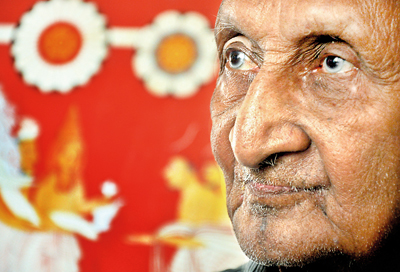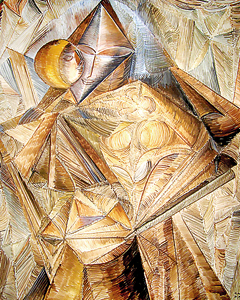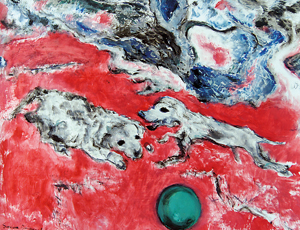An exhibition at 92
Liyanamanage Kulatunge Karunaratne is holding an exhibition of paintings and drawings this week. He has just turned 92. His birthday was on June 21.
Almost all the visual impressions and copies of works of art from across the country which form his “portfolio”, meticulously done during and after his career at the Department of Archaeology, will be on display at the exhibition titled, ‘Purasanda’.
The exhibition of more than 250 works of art by L.K. Karunaratne will be from August 17 to19 at the Art Gallery in Colombo.

The artist and his work. Pix by Amila Gamage
Some of the original works of art that he copied may already be lost to posterity, old friend Prabath Wijesekera (former Head of Exhibitions of the National Museum), who is helping with the preparations for the exhibition tells the Sunday Times, citing some of the Sigiriya frescoes.
It was Mr. Karunaratne’s work at the Department of Archaeology under the “one and only” Dr. Senarath Paranavitane that propelled him to engage in detailed drawings, we learn when we visit him at his home in Kotte where he lives with his daughter Anoma, son-in-law Ananda Gunawardena and granddaughter Kushani.
Having had his early education at Sri Rahula College in his hometown of Katugastota, he had later joined Ananda College, Colombo, going on to the Technical College, Maradana, to master the craft of draftsmanship, the Sunday Times gathers from his family. A short stint at the Irrigation Department had ended with his life’s work starting at the Archaeology Department in 1947.
“I was very interested in archaeology,” says Mr. Karunaratne, a Chartered Architect, “for it provided scope for seeing.”
A little coaxing by family and Mr. Wijesekera leads him back in time to the “conjectural drawings” of the Kuttam Pokuna (Twin Ponds) at Anuradhapura that he undertook after Dr. Paranavitane found several “waterholes” scattered everywhere.
These were just a few of many, including the detailed drawings of the Sigiriya frescoes he had done, with the copies he made being the only evidence of some beauties who have got wiped off the face of the rock now.
Although he retired from the department in 1987, his work did not end. In 1987 he went as Project Director, Conservation, to Polonnaruwa under the Central Cultural Fund, his daughter recalls.
“I was the architect of the building housing the Polonnaruwa Museum,” smiles Mr. Karunaratne, while Mr. Wijesekera fills the gaps in memory, reminding him how he undertook the restoration of the Alahana Pirivena and also the Mihintale stupa and pinnacle.
Documents at Mr. Karunaratne’s home also indicate the hand that he had in recreating the beautiful 14-foot lamp of the church in the Jaffna Dutch fort; the prakaraya around the dagoba of the Kalutara Bodhiya; and the re-designing of the Army insignia when Sri Lanka became a republic.
He had also been part of the group headed by Dr. Roland Silva which decided not only on the exhibits, including the blood-splattered national suit of then Prime Minister S.W.R.D. Bandaranaike on the day he was shot and the pistol that was used, but also designed the museum in which they would be kept at the BMICH.
Describing the works of art of Mr. Karunaratne, Mr. Wijesekera says they include visual impressions as well as copies of originals. The large boards are pulled out for us to view, as Mr. Wijesekera explains that Mr. Karunaratne did line drawings of what he saw, not to the same scale but smaller, citing the ‘Lord Buddha and Makara’ at the Lankathilaka in Kandy.
The Vessantara Jathaka story from Degaldoruwa, Kandy, and many of the Sigiriya frescoes have been painstakingly traced and copied, points out Mr. Wijesekera who creates an image of Mr. Karunaratne climbing scaffoldings if the paintings were high above, stretching up, lying down or crouching to engage in his passion of drawing.
These line drawings would have been very difficult to do, he says, pointing out that some of the original frescoes that Mr. Karunaratne copied are no more, having got peeled off the face of Sigiriya.
In some instances, like at the Tivanka Pilimage, Mr. Karunaratne has traced the images and then transferred the picture to special paper called Whatman and Kent. Then he would have taken it back to the site to get the detail and the shading, he adds.
It is ironic that Mr. Karunaratne himself, referring to Sittara artists (who excelled in the painting of birth stories of the Buddha on temple walls in the 18th century), wrote way back in 1948 in the ‘Vesak’ issue of the Ceylon Daily News that at least the few works of art left should be preserved.
What he urged then that if they are preserved “we have indeed a collection to be proud of and one from which artists for years to come could draw inspiration in evolving a truly Ceylonese style of painting” holds true more than 60 years later for his own works of art.
comments powered by Disqus






















